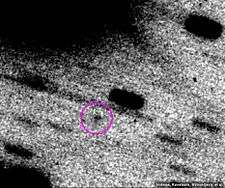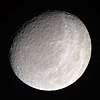Francisco (moon)
 | |
| Discovery | |
|---|---|
| Discovered by | |
| Discovery date | August 13, 2001[1][2] (confirmed in 2003[1][3]) |
| Designations | |
| Adjectives | Francisconian |
| Orbital characteristics | |
Mean orbit radius | 4,276,000 km[4][5] |
| Eccentricity | 0.1459[5] |
| 266.56 d | |
| Inclination | 145° (to the ecliptic)[4] |
| Satellite of | Uranus |
| Physical characteristics | |
Mean radius | 11 km (estimate)[6] |
| ~1,500 km2 (estimate) | |
| Volume | ~6,000 km3 (estimate) |
| Mass | ~7.2×1015 kg (estimate) |
Mean density | ~1.3 g/cm3 (assumed) |
| ~0.0025 m/s2 (estimate) | |
| ~0.0094 km/s (estimate) | |
| ? | |
| ? | |
| Albedo | 0.04 (assumed)[6] |
| Temperature | ~65 K (estimate) |
|
| |
Francisco (/frænˈsɪskoʊ/ fran-SIS-koh) is the innermost irregular satellite of Uranus.
Francisco was discovered by Matthew J. Holman, et al. and Brett J. Gladman, et al. in 2003 from pictures taken in 2001 and given the provisional designation S/2001 U 3. Confirmed as Uranus XXII, it was named after a lord in William Shakespeare's play The Tempest.[7]
See also
References
- 1 2 Green, Daniel W. E. (2003-10-07). "IAUC 8216: S/2001 U 3". IAU Circular. Retrieved 2011-01-08.
- ↑ Blue, Jennifer (2008-10-16). "Planet and Satellite Names and Discoverers". Working Group for Planetary System Nomenclature (WGPSN). Retrieved 2008-12-19.
- ↑ Sheppard, Scott S. "New Satellites of Uranus Discovered in 2003". Institute for Astronomy at the University of Hawaii. Archived from the original on January 16, 2009. Retrieved 2008-12-19.
- 1 2 Sheppard, Jewitt & Kleyna 2005, p. 523, Table 3.
- 1 2 Jacobson, R.A. (2003) URA067 (2007-06-28). "Planetary Satellite Mean Orbital Parameters". JPL/NASA. Retrieved 2008-01-23.
- 1 2 Sheppard, Jewitt & Kleyna 2005, p. 523, Table 3 ... ri (km) ... 11 ... i Radius of satellite assuming a geometric albedo of 0.04.
- ↑ "Planet and Satellite Names and Discoverers". Gazetteer of Planetary Nomenclature. USGS Astrogeology. July 21, 2006. Retrieved 2006-08-06.
- Sheppard, S. S.; Jewitt, D.; Kleyna, J. (2005). "An Ultradeep Survey for Irregular Satellites of Uranus: Limits to Completeness". The Astronomical Journal. 129: 518. arXiv:astro-ph/0410059. Bibcode:2005AJ....129..518S. doi:10.1086/426329.
External links
This article is issued from
Wikipedia.
The text is licensed under Creative Commons - Attribution - Sharealike.
Additional terms may apply for the media files.

